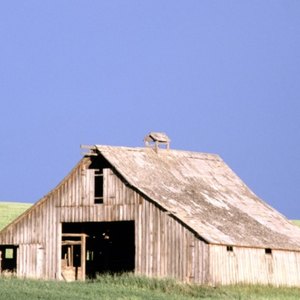
The value of an old barn varies widely depending on its condition, location, size and the materials with which it was constructed. As with any unique item, an old barn is worth what someone is willing to pay for it, so a motivated buyer can substantially increase a particular barn's selling price.
Value
Every old barn is a unique item in a unique situation, and this is part of what gives old barns their value in a mass-produced world. A small barn of 30 by 30 feet or less, in reasonable condition, can be bought for around $10,000, but this doesn't include the cost of dismantling and moving it. A very large barn with hand-hewn beams and historical significance can run well over $50,000. When buying an old barn, remember that peripheral costs are a major consideration. Waste disposal, transportation, storage and hiring professional help all cost a lot of money.
Condition
Barn buyers' motivations vary. Some people buy barns solely for their materials, while others intend to reconstruct the barn in a new location and use it, either as a barn or renovated into a house or studio. The condition of a barn is less important to materials salvagers than to the re-users. In the first case, as long as the wood isn't rotten, it can be used. For re-use, a barn needs to be in good enough condition that it's financially feasible to restore it. Barns that have collapsed will almost always be sold only for materials.
Materials
The main attraction of old barns is their wood. Barns built in the 19th century often feature wooden beams that are unavailable today. A hand-hewn, 50-foot-long oak beam that was made from an old growth oak tree may be worth thousands of dollars because of its rarity. Because most modern lumber comes from faster-growing, younger trees, it isn't as strong as older lumber. Weathered barnboard is also popular for decorative purposes, and can only be found on buildings where it has aged for decades.
Location
Barns, by their nature, tend to be large and bulky. Taking apart a barn and moving it is a major operation that can cost a lot of money. Barns with extremely long beams may require special vehicles to move them. Because of the cost of transportation, barns that are close to population centers are worth more than barns in remote areas. Just as population pressure increases the value of land and houses, it also increases the value of items that would cost a lot to move a long distance.
References
Resources
Writer Bio
Jagg Xaxx has been writing since 1983. His primary areas of writing include surrealism, Buddhist iconography and environmental issues. Xaxx worked as a cabinetmaker for 12 years, as well as building and renovating several houses. Xaxx holds a Doctor of Philosophy in art history from the University of Manchester in the U.K.

